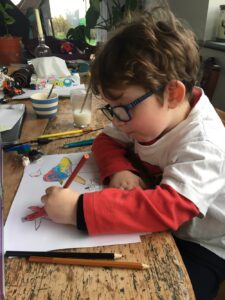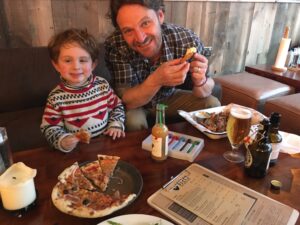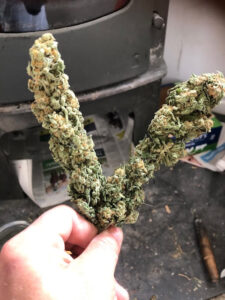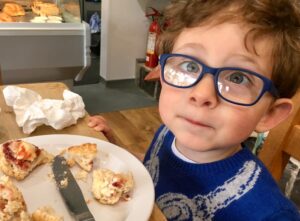When their son was diagnosed with a rare brain tumour, Jessica and Simon Edwards turned to cannabis. They have chosen to share their story to address the stigma around its use in paediatric cancer.
James Edwards was beautiful and full of life. He found joy in everything, sitting for hours completing jigsaw puzzles aimed at children twice his age. At the age of four he was a talented artist, one of his paintings was even included in the Young Artist Summer Show at the Royal Academy of Arts earlier this year.
James was two-and-a half years old when he first began developing a squint in one of his eyes. Up until then he had been a healthy toddler, albeit a poor sleeper who occasionally suffered night terrors.
When he started to complain of headaches his parents took him to the doctor, who initially suggested James was making it up. Ten days later his leg was beginning to tremble and they were sent for an emergency MRI scan. The diagnosis was one of every parent’s worst nightmares.
James had diffuse intrinsic pontine glioma (DIPG), a rare, aggressive and incurable brain tumour.
He was rushed to hospital in Bristol, a three hour drive from the family’s home in Cornwall, where he underwent emergency surgery to relieve the pressure on his brain.
“The next morning, the oncologist came around and told us that there was absolutely nothing that could be done,” says mum Jessica.
“Some children only last weeks, but he gave him six to eight months maximum. We asked about every possible thing, including changing his diet. We were told it wouldn’t matter if we gave him nothing but chicken nuggets for the rest of his life.”
She adds: “They tell you not to do your own research, but we knew we had to do our own thing.”

James was a talented artist

Some of James’ artwork
The only option
It was a matter of weeks before Jessica and his dad Simon came across cannabis as something which could potentially help their son.
The family relocated to Sam’s House in Bristol, which provides accommodation for families of children with cancer, while James began six weeks of radiotherapy.
It was here that they received a call from a family friend saying they knew someone who makes oil for people living with conditions such as Parkinson’s, epilepsy and arthritis.
They posted the capsules to them and Jessica and Simon would squeeze the oil out of the capsule onto a spoon and give it to James in tiny amounts.
“We didn’t know what we were doing, we were winging it a bit, but it was the only choice we could make,” says Jessica.
“We had to start low and give it to him in small amounts, gradually building up until we reached a point where he was happy and comfortable. We gave him little bits throughout the day and he never showed any discomfort but he was laughing and eating.”
Simon adds: “James was the one who was letting us know if it was working or not and how much to give him, we were guided by him.
“If in the first few weeks we had seen a negative effect or thought he wasn’t comfortable then we would have stopped, but the effects were instantly positive.”
“Obviously we were really nervous about [the hospital] finding it in his blood tests, but they never knew,” continues Jessica.
“They told us that he would most likely become neutropenic during the radiotherapy, which means that the platelets in your blood are so low that your immunity is too low to continue with the treatment. Instead, all the other parents we were living with thought James was the sibling of a sick child, because he looked so well.”

James with dad, Simon Edwards
Living with hope
The family returned home in December 2018, a month after medical cannabis had been legalised in the UK.
They contacted a private cannabis clinic in London, but the prescription was going to cost £1,200 a month and was unaffordable for two parents who were caring for their son full-time.
Despite initially finding someone local who could supply the oil, they became too unreliable and the couple decided this was something they had to do themselves.
Simon didn’t know anything about cannabis, but he threw himself into it and dedicated the next year of his life to caring for James and the plants.
“I started researching all the nutrients, I obviously wanted it to be the best, so it all had to be organic. I made a sativa strain for the day and an indica for the night,” he says.
“My whole life was just James and the plants. I did anything I could, which is what any parent would do. It was hugely helpful for my mental health as well because tending to the plants gave me something to focus on.”

Simon learned everything he could about growing cannabis.
Once they saw the positive effects the cannabis was having on James, Jessica and Simon were open about it with friends, family and neighbours.
“We told them after we’d been giving him the cannabis for several weeks, and they could see how well he was doing,” continues Simon.
“There were moments when I worried about being raided, because you do get to the point where you think you don’t know who knows and who doesn’t anymore.
“Our neighbours who were both nearly 90 said ‘whatever you’re doing, keep doing it’. Our friends came round to water plants for us when we were away at the hospital.”
James continued to meet his milestones and even started school full-time. His doctors were amazed at how well he was doing.
“I hated lying to the doctors,” says Jessica.
“We were so proud of what we were doing that I just wanted to scream it from the rooftops. We would go back once every three months for MRI scans and they would be stable. The doctors thought it was incredible when they saw him running up the corridor, when he was supposed to have been severely disabled by that point. We were quite convinced that we’d beaten it.
“You have to live with hope and that’s what cannabis gave us. Without that I don’t know how we would have been able to function, we had to believe with every cell of our body that he was going to beat it.”
Simon adds: “Right up until he died in my arms, I was convinced that he was going to be fine.”

Friends helped water the plants while the family enjoyed a holiday in Greece.
It could have been different
After three years of stable scans, during the first lockdown of 2020 James developed a limp again. He underwent more radiotherapy and was able to return to school part-time in September, on a higher dose of cannabis.
But a cyst developed on the tumour and unfortunately there was nothing the doctors could do. The symptoms became progressively worse. In December, he lost the use of his legs, then his hands and then he couldn’t smile, talk or swallow.
James was no longer able to hold the cannabis oil under his tongue, on top of the morphine and steroids he was having to take.
“We just simply could not get enough of it into him anymore. He was impossible to reason with and he was suffering. We were asking too much of him,” says Jessica.
“If we’d had help from professionals to administer it differently, to get it straight into his blood rather than through his digestive system and the support and confidence to give him stronger doses then things could have been different.
Seven weeks later, in March 2021, James sadly passed away. Even if it hadn’t cured him, James’ parents believe that with the support of his doctors, James could have had peace at the end.
“There was a change in him from the moment we could no longer give him cannabis, it just sped everything up,” says Simon.

Tackling the stigma
Even though cannabis is now prescribed legally for children with intractable epilepsy in the UK, there is still a huge stigma around its use in paediatric cancer. It is usually accessed through the illicit market, and as a result it’s rare for a family to speak out about their experience.
Jessica and Simon want to share James’ story in the hope of breaking down some of that stigma and encouraging an open dialogue about cannabis and its potential as a therapeutic in cancer treatment.
“The only thing I would change would be to give him a higher dose,” says Jessica.
“But we wanted him to have a quality of life, he was such a passionate, funny, beautiful boy.”
She continues: “Cannabis might not cure cancer, but at least it’s an incredible complementary therapy. Why is it okay to give a child chemotherapy which is a chemical, which makes them sick and their hair fall out and turns them grey, but it’s not okay for a child to take cannabis? We were living in total fear, but it shouldn’t have been like this. It could have been done differently with the right knowledge and open dialogue.”
Simon adds: “We want to help even just one parent to find some hope. If we had gone through this without cannabis, I just can’t imagine the hell that would have been.”

Simon and Jessica visiting James’ work at the Royal Gallery of Art this summer.
This article was produced in collaboration with Medcan Support, for more information and resources visit www.medcansupport.co.uk
The post Cannabis and childhood cancer: “It gave us hope that we could save our son” appeared first on Cannabis Health News.

